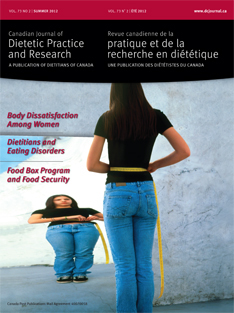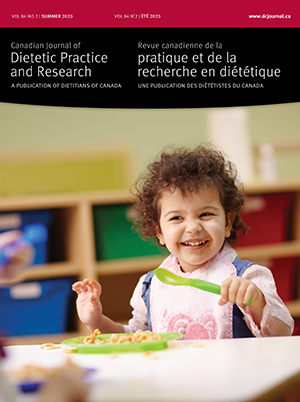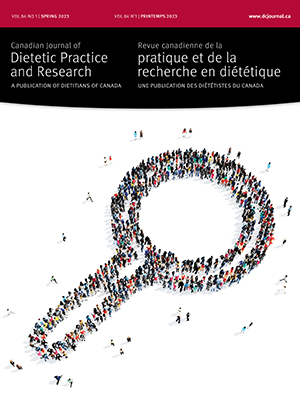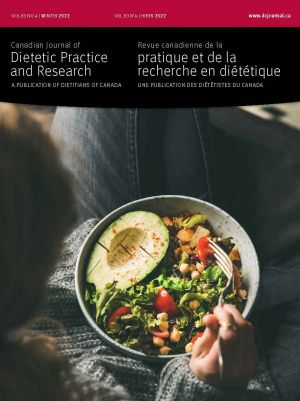Volume 73 • Number 2 • July 2012
Chair’s Message
Editor’s Message
Research
Purpose: We examined whether participation in a food box program has a positive effect on fruit and vegetable consumption and food security. Methods: Participants and nonparticipants in a food box program were surveyed to determine differences between the two groups and change over time. Results: Fruit and vegetable intake declined in those who left the program after several months, and intake of fruit, carrots, and vegetables was lower among those who had left than among those who remained in the program. Food insecurity was associated with lower intakes of fruit and vegetables. Conclusions: Participation in a food box program can provide some benefit in terms of increased fruit and vegetable consumption for those who use the program regularly. Increasing the frequency of the box and encouraging continued use may improve these effects.
Purpose: Healthy eating during early childhood is important for growth and development. Eating Well with Canada's Food Guide (CFG) provides dietary recommendations. We investigated patterns of food consumption among preschool children and attempted to determine whether these children's intakes met nutrition recommendations. Methods: Between 2005 and 2007, four- and five-year-old children (n=2015) attending 12 Edmonton-region public health units for immunization were recruited for a longitudinal study on determinants of childhood obesity. The children's dietary intake at baseline was assessed using parental reports. Results: Overall, 29.6%, 23.5%, 90.9%, and 94.2% of the children met recommendations for vegetables and fruit, grain products, milk and alternatives, and meat and alternatives, respectively. In addition, 79.5% consumed at least one weekly serving of foods in the “choose least often” group. Significant differences existed in consumption of food groups across socioeconomic and demographic groups. For example, 82.9%, 84.7%, and 75.9% of preschool children from neighbourhoods of low, medium, and high socioeconomic status, respectively, consumed at least one food in the “choose least often” group (χ2 =16.2, p<0.001). Conclusions: Consumption of vegetables and fruit and grain products was low among participants, and intake of “choose least often” foods was high. Consumption of foods also differed among socioeconomic and demographic groups. To encourage healthy eating among children, public health professionals should target groups who do not meet the CFG recommendations.
Purpose: Eating behaviours were assessed among pregnant women in a mid-sized Canadian city. Methods: As part of the Prenatal Health Project, we interviewed 2313 pregnant women in London, Ontario. Subjects also completed a food frequency questionnaire. Recruitment took place in ultrasound clinics at 10 to 22 weeks of gestation. The main outcome measures were number of daily servings for each food group, measured against the minimum number recommended by the 2007 Eating Well with Canada’s Food Guide (CFG), the proportion of women consuming the recommended number of servings for each and all of the four food groups, and factors associated with adequate consumption. We also determined the number of servings of “other foods.” Analysis included descriptive statistics and logistic regression, all at p<0.05. Results: A total of 3.5% of women consumed the recommended number of servings for all four food groups; 15.3% did not consume the minimum number of servings of foods for any of the four food groups. Women for whom this was their first pregnancy were less likely to consume the recommended number of servings from all four food groups (odds ratio=0.41; confidence interval=0.23, 0.74). Conclusions: Very few pregnant women consumed food group servings consistent with the 2007 recommendations. Strategies to improve dietary behaviours must focus on the establishment of healthy eating behaviours among women of reproductive age.
Purpose: Associations were examined between body image and body mass index (BMI) in comparison with body composition in healthy weight, overweight, and obese young adults. Methods: Weight and height were determined, and the percentage of fat mass (%FM) and percentage of fat-free mass (%FFM) were measured by dual energy X-ray absorptiometry in 75 male and 87 female young adults (21.1 ± 1.9 years; 25.2 ± 4.4 kg/m2 [mean ± standard deviation]). Body image was measured using the three subscales Weight Esteem, Appearance Esteem, and External Attribution of the Body-Esteem Scale for Adolescents and Adults (BESAA). Results: Body mass index and %FM were highly correlated (r for males = 0.74, r for females = 0.82; both p<0.001), and were inversely associated with body image, particularly Weight Esteem. After adjustment for physical activity, BMI and %FM (and %FFM, although in the opposite direction) were associated with each BESAA subscale: %FM, %FFM, and BMI explained 12% to14% of the variance in Appearance Esteem for both sexes, 33% to 41% in Weight Esteem in women and 16% to 18% in men, and 8% to 10% in External Attribution in women (all p<0.05) and <5% for men (NS). Conclusions: Clinicians should be aware that as their clients’ BMI and %FM increase, body image decreases, particularly in women.
Purpose: We examined the demographic characteristics of applicants who applied and were unsuccessful in securing an internship position, what these applicants did afterward in their efforts to obtain an internship position, and which career paths they pursued. We also searched for any differences in eligibility between applicants who had not obtained an internship position and those who eventually were successful. Methods: A 68-item online survey was administered. Results: The study sample (n=84) was relatively homogeneous: female (99%), heterosexual (98%), Caucasian (70%), Canadian-born (75%), having English as a first language (73%), multilingual (40%), and having completed a previous degree (29%). Mean self-reported cumulative grade point average (3.35) exceeded the minimum (3.0) required by most Ontario internship programs. Over 25% eventually secured an internship position. Applicants who rated their packages strong in community nutrition were less successful in attaining an internship. Little difference in qualification was found between those who were eventually successful and not-yet-successful applicants. Conclusions: Unsuccessful applicants met academic and other requirements for admission to dietetic internship programs in Ontario. Insufficient training opportunities, costs associated with internship, and competition may be contributing to a loss of human potential in dietetics.
Perspectives in Practice
The prevalence of eating disorders is higher in university nutrition faculties than in other faculties. We examined beliefs about and approaches to eating disorders in nutrition education faculties around the world. We developed a questionnaire specifically for this project and distributed 664 copies electronically, using contact information obtained in collaboration with Dietitians of Canada and the International Confederation of Dietetic Associations. Using the 101 questionnaires returned from 14 countries, we found that 77% of respondents felt eating disorders are a concern among nutrition students; however, only 15% of programs had policies/procedures to help address these disorders. Forty-eight percent of respondents thought screening for eating disorders would be a good idea; however, 78% of them believed screening would involve ethical issues. In conclusion, eating disorders are a concern in nutrition faculties around the world, and while most feel something should be done, ethical dilemmas contribute to confusion over the best approach. More work is needed in this area.
A team of researchers undertook a collaborative qualitative study to explore beginning dietitians’ life experiences and the meaning ascribed to those experiences in the context of dietetic practice. Data were collected using Seidman's three-step in-depth phenomenological interviewing method with 12 beginning dietitians who were graduates of the three participating dietetic programs. We outline the collaborative research process and highlight a writing and data analysis technique described as the collaborative retreat, a face-to-face, two-day gathering that facilitated the researchers’ collective decision-making and organization, discussion, and analysis of this complex qualitative data set. Use of a listening guide aided researchers’ understanding and interpretation of participant voices. Researchers concluded that the overall collaborative qualitative research process was positive and self-fulfilling, and that it resulted in multiple benefits for them individually and the research project collectively. Researchers were able to work through methodological and theoretical issues as these arose, with the assistance of technology, writing, listening, and dialogue. Relationship building and relationship maintenance emerged as factors critical to the success of the research process. Collaborative research teams that are committed to listening, writing, and dialogue will find that the collaborative retreat can be a productive site of knowledge generation and mentorship.
Report
Purpose: An investigation was completed to determine how typical cooking procedures used in food preparation, such as baking and stir-frying, affect trans fats formation. Methods: Canola oil was used as the main fat ingredient. Zucchini cake and gingersnap cookies were baked at 180° C and 200° C, while stir-fried chicken was prepared at 200° C and 275° C. The lipids from the food were extracted following the Folch procedure, and analyzed for trans fatty acids according to ISO official method 15304. Results: Minimal changes were observed in the amount of trans fats during baking. Application of extreme temperatures during baking, which caused carbonization of the outer layer of products, yielded an insignificant increase in the amount of trans isomers. As with baking, stir-frying did not result in significant isomerization of the fatty acids, even when the oil was heated to 275° C and smoking heavily before the food was placed in it. Irrespective of the cooking procedure, linolenic acid was the most prone to isomerization with the highest amount of trans isomers formation. Conclusions: Baking and stir-frying at normal and/or extreme temperatures do not significantly affect the amounts of trans fats. Likewise, heating oil to the smoking point during stirfrying may decrease the amount of polyunsaturated fatty acids because of oxidative degradation.
Review
With the growing pervasiveness of mass media, individuals of all ages and both sexes are bombarded with images that glorify youthfulness, messages that tie self-worth to thinness, and products that promise youth and beauty forever. Aging women are vulnerable to these societal messages and experience strong pressures to maintain their youth and thinness. As the physiological changes that accompany normal aging move these women farther from the “ideal” image, body dissatisfaction may increase. These women are confronted with the impossible task of trying to defy the natural process of aging through a variety of means, including fashion, cosmetics, selective surgeries, and personal food choices. The resulting body image issues, weight preoccupation, and eating disturbances can lead to voluntary food restriction, depression, social withdrawal, lower self-esteem, and disordered eating, all of which can have a negative impact on quality of life and nutritional status. In this review we explore existing research on body dissatisfaction among middle-aged (30 to 60) and older (over 60) women, discuss the prevalence of body dissatisfaction, its predisposing risk factors, and the resulting eating and body maintenance behaviours, and examine implications for dietetic practice.










